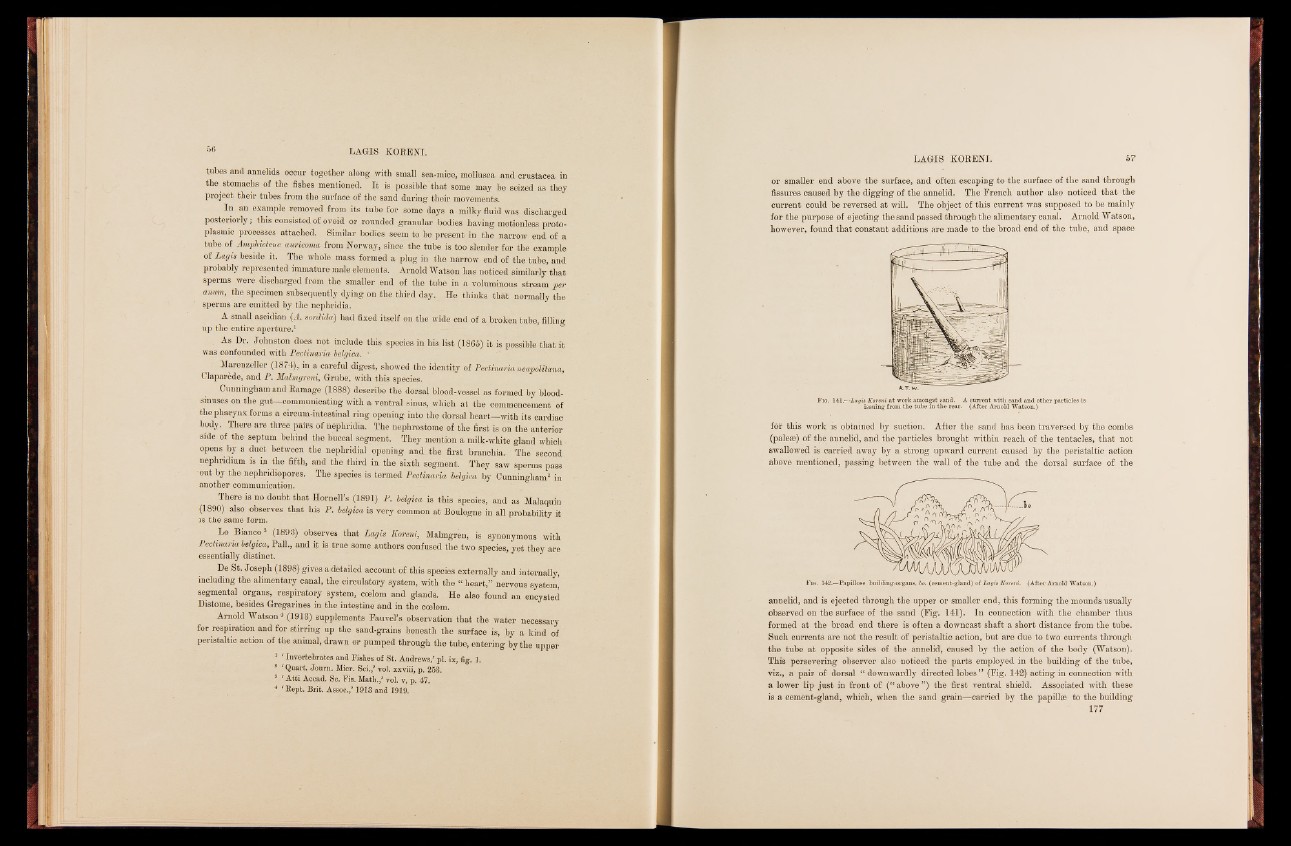
tubes and annelids occur together along with small sea-mice, mollusca and Crustacea in
the stomachs of the fishes mentioned. It is possible “that some may be seized as they
project their tubes from the surface of the sand during their movements.
In an example removed from its tube for some days a -milky fluid was discharged
posteriorly; this consisted of ovoid or rounded granular bodies having motionless protoplasmic
processes attached. Similar bodies seem to be present in the narrow end of a
tube of Amphictene am-icoma from Norway, since the tube is too slender for the example
of Lagis beside it. The whole mass formed a plug in the narrow end of the tube, and
probably represented immature male elements. Arnold Watson has noticed similarly that
sperms were discharged from the smaller end of the tube in a voluminous stream per
anum, the specimen subsequently dying on the third day. He thinks that normally the
sperms are emitted by the nephridia.
A small ascidian {A, sordida) had fixed itself on the wide end of a broken tube, filling
up the entire aperture.1
. As Dr. Johnston does not include this species in his list (1865) it is possible that it
was confounded with Pectin-aria belgica. •
Marenzeller (1874), in a careful digest, showed the identity of Pectmamneapolitana,
Claparede, and P. Malmgreni, Grube, with this species.
Cunningham and Ramage (1888) describe the dorsal blood-vessel as formed by blood-
sinuses on the gut—communicating with a ventral sinus, which at the commencement of
the pharynx forms a circum-intestinal ring opening into the dorsal heart—with its cardiac
body. There are three pairs of nephridia. The nephrostome of the first is on the anterior
side of the septum behind the buccal segment. They mention a milk-white gland which
opens by a duct between the nephridial opening and the first branchia. The second
nephridium is in the fifth, and the third in the sixth segment. They saw sperms pass
out by the nephridiopores. The species is termed another communication. Pectinaria belgica by Cunningham* in
There is no doubt that Homell’s (1891) P. belgica is this species, and as Malaquin
i(s1 8th9e0 )s aamlseo foobrmse.rves that his P. belgica is very common at Boulogne in all probability it
Lo Bianco3 (1893) observes that Lagis Koreni, Malmgren, is synonymous with
ePsescetnintiaanllay bdeilsgtiicnac, tP. all., and it is true some authors confused the two species, yet they are
De St. Joseph (1898) gives a detailed account of this species externally and internally,
including the alimentary canal, the circulatory system, with the “ heart,” nervous system,
segmental organs, respiratory system, coelom and glands. He also found an encysted
Distome, besides Gregarines in the intestine and in the coelom.
Arnold Watson4 (1913) supplements Fauvel’s observation that the water necessary
for respiration and for stirring up the sand-grains beneath the surface is, by a kind of
peristaltic action of the animal, drawn or pumped through the tube, entering by the upper
1 f Invertebrates and Pishes of St. Andrews/ pi. ix, fig. 1.
2 ‘ Quart. Journ. Micr. Sci./ vol. xxviii, p. 253.
3 S Atti Accad. Sc. Fis. Math./ vol. v, p. 47.
* ‘ Rept. Brit. Assoc./ 1913 and 1919.
LAGIS KORENI. 57
or smaller end above the surface, and often escaping to the surface of the sand through
fissures caused by the digging of the annelid. The French author also noticed that the
current could be reversed at will. The object of this current was supposed to be mainly
for the purpose of ejecting the sand passed through the alimentary canal. Arnold Watson,
however, found that constant additions are made to the broad end of the tube, and space
Fig. 141.—Lagisi sKsuoirnegni f arotm w othrke atumboen igns tt hsaen rde.a r. A (cAurfrteern tA wrniothld s Wanadt saonnd. )other particles is
for this work is obtained by suction. After the sand has been traversed by the combs
(palese) of the annelid, and the particles brought within reach of the tentacles, that not
swallowed is carried away by a strong upward current caused by the peristaltic action
above mentioned, passing between the wall of the tube and the dorsal surface of the
Fig . 142.—Papillose building-organs, bo. (cement-gland) of Lagis Koreni. (After Arnold Watson.)
annelid, and is ejected through the upper or smaller end, this forming the mounds usually
observed on the surface of the sand (Fig. 141). In connection with the chamber thus
formed at the broad end there is often a downcast shaft a short distance from the tube.
Such currents are not the result of peristaltic action, but are due to two currents through
the tube at opposite sides of the annelid, caused by the action of the body (Watson).
This persevering observer also noticed the parts employed in the building of the tube,
viz., a pair of dorsal “ downwardly directed lobes” (Fig. 142) acting in connection with
a lower lip just in front of (“ above”) the first ventral shield. Associated with these
is a cement-gland, which, when the sand grain—carried by the papillae to the building
177